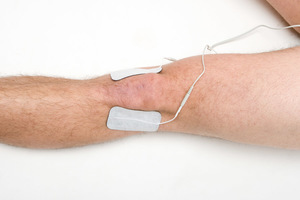Knee injuries may include ligament sprain, tendon tear or cartilage tear
Ligament sprains
Sudden twists or excessive force on the knee joint can stretch ligaments beyond their capacity. Torn ligaments can bleed into the knee and typically cause swelling, pain and joint laxity. The anterior cruciate ligament (ACL) situated in the centre of the joint is the knee ligament commonly injured.
A ruptured ACL does not heal by itself and may require reconstructive surgery.
Tendon tears
The muscles are anchored to the joints with tendons. Overstretched tendons can tear and bleed. These injuries tend to heal with the aid of physical therapy and exercise.
Cartilage tears
The knee joint is cushioned with a special type of cartilage called ‘menisci’. One of the most common knee injuries is a torn or split meniscus. Tears of the meniscus can also occur in older people due to wear and tear. Symptoms include swelling, pain and the inability to straighten the leg.
SportsMed TENS therapy for Knee injuries
After a diagnosis of knee damage, your injury management plan should include treatment as often as possible.
SportsMed is the TENS, ECS and EMS machine we suggest to aid repair of a mild or moderate knee injury.
SportsMed electrotherapy can be used everyday - outside the clinic - for drug-free, on-demand pain relief. It is also designed and programmed to aid circulation, reduce inflammation, hasten healing and help with muscle strengthening.
User guide
Please read the User Guide which comes with your TENS unit
Pad placement - Knee injuries
Pain relief - place pads where they are comfortable and most effective for pain relief
Injury healing - pads are placed at the location of the injury
Muscle rehabilitation - the generic advice is to place one pad at the top of the muscle and the second pad one-third along the length of the muscle you wish to strengthen. You may need to consult your physiotherapist for specific guidance on which muscles to target.
If you have any questions please phone our office for further advice.



